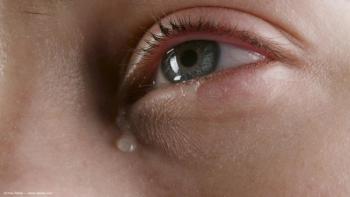
Why Acanthamoeba diagnosis is often challenging
Having an awareness of current best practices-such as epidemiology, risk factors, signs and symptoms, and tests-can be key to identifying and treating corneal infections.
Reviewed by Jeremy D. Keenan, MD, MPH
Many cases of Acanthamoeba keratitis go undiagnosed, and consequences can be devastating, according to Jeremy Keenan, MD, MPH.
“It’s an uncommon cause of cornea infections, but it’s a really bad one,” said Dr. Keenan, associate professor of ophthalmology, University of California, San Francisco. “If you were to pick, you would not want this one.”
Related:
Ever since an outbreak was traced to a solution for contact lens care (AMO Complete Moisture Plus) in 2004, reports of Acanthamoeba have infection remained higher than before that time, Dr. Keenan said.
“This could be because people are more aware of it,” he said. The availability of the confocal microscope has made it easier to identify the organism.
In Western countries, about 85% of cases occur in contact lens wearers. In the United States, the incidence of infection is about 0.15 per million in non-contact lens wearers and 1 per million in contact lens wearers.
Recent:
By contrast, in the United Kingdom, the incidence is about 1 per million in non-contact lens wearers and 20 per million in contact lens wearers. The organism lives in drinking water, and one explanation for the higher incidence in the United Kingdom could be the use of water storage tanks above houses, Dr. Keenan said.
The incidence of infection increases in the summer months, most likely because water sports such as swimming and boating are more common then, he added.
More:
Poor contact lens hygiene, such as washing lenses in tap water or showering while wearing contact lenses, can increase the risk.
Researchers have identified 25 species based on morphology, with A. castellanii and A. polyphaga the most common found in keratitis. The organism takes 2 forms. Under harsh conditions it forms a cyst about 10-30 microns in size. As a cyst, it does not require food, and becomes resistant to extremes in temperature, pH balance, dessication and chemicals and is difficult to kill.
In the presence of food it becomes a trophozoite, which is more susceptible to treatment. As a trophozoite it is 20-50 microns in size and motile. It replicates by binary fission. It feeds on algae, bacteria, other protozoans and possibly keratocytes in the cornea.
Patients experience redness, photophobia, tearing and pain often disproportionate to the clinical signs, but some also have reduced corneal sensation and may not feel pain.
In North America and Europe, 37%-46% of cases involve only the epithelium, never reaching the stroma. That’s less common in China and India, perhaps due to delayed presentation.
Related:
Confocal microscopy offers a good opportunity to diagnose Acanthamoeba, but it requires experience. “The first few you look at, you think everything is Acanthamoeba,” said Dr. Keenan.
In the epithelium, the infection often appears in less than one month as a punctate keratopathy with a diffusely rough appearing corneal surface but no frank epithelial defect.
Also in early epithelial cases, linear staining can appear. This staining can appear dendritic. As a result, many patients present after being treated with steroids because of a misdiagnosis of herpes infections.
Recent:
The pseudodentrite associated with Acanthamoeba differs from herpetic dendrite in that there is no epithelial defect and no terminal bulb. Interstitial keratitis due to herpes simplex virus tends not to be multifocal and often affects the mid and deep stroma, while Acanthamoeba infiltrates are usually numerous, smaller and multifocal.
Perineural infiltrates appear in the peripheral cornea, often surrounding 1-2 nerves. These take the form of linear, radial structures only 1-2 mm in length, with indistinct borders.
Limbitis is very common, but may be less marked in eyes receiving topical corticosteroids.
Recent:
Also at this stage, patchy anterior stromal infiltrates may appear. They are usually not dense and often have no overlying epithelial defect, said Dr. Keenan. Acanthamoeba should be considered when diagnosing other conditions with subeithelial infiltrates, such as epidemic keratoconjunctivitis or contact lens related infiltrates, he added.
After a month or so, new signs may appear. These could include a large ring involving the central cornea. This may start without an epithelial defect, but usually a defect forms over and within the ring. These appear in 20% to 30% of Acanthamoeba cases.
“If you let it go, the most common thing you see is ring infiltrate,” said Dr. Keenan. “That’s the classic sign. If you don’t treat it, it gets deeper and deeper, and once it’s in the stroma it can be pretty bad.”
Also in later stages, large nonhealing epithelial defects with nopurulent stromal infiltration may appear, often accompanied by cornea vascularization and edema.
More:
Uveitis and scleritis may emerge at this point, too, with keratic precipitates, anterior chamber cellular reaction and scleritis usually worse near the limbus.
Confocal microscopy is a relatively new test for Acanthamoeba keratitis, Dr. Keenan said. He recommends starting with central scans of the epithelium and anterior stroma where cysts will often be visible even in the absence of a frank central infiltrate. He then recommends scanning the edges of any infiltrates, focusing on the epithelium and anterior stroma.
He described cysts as round, hyper-reflective bright spots and double-walled structures. Trophozoities are hard to visualize, he said, and so are cycsts in eyes already being treated with antiamoebics.
Dr. Keenan also warned against confusing the nuclei of epithelial cells and inflammatory cells for Acanthamoeba cysts. Nuclei of epithelial cells are round structures in the superficial epithelium, regularly spaced, often without surrounding inflammatory cells.
Inflammatory cells are round structures without double walls. Lobular forms often appear within the round structure. They are not often as perfectly spherical, large or bright as Acanthamoeba cysts, though macrophages are similar in size, said Dr. Keenan.
Related:
Since not everyone has a confocal microscope or the expertise to use it for identifying Acanthamoeba, many ophthalmologists refer suspected Acanthamoeba cases to academic centers, said Dr. Keenan.
Corneal scraping remains the best way to diagnose Acanthamoeba, by smear, culture or polymerase chain reaction, said Dr. Keenan. But some laboratories miss the diagnosis because specimens are smaller than they are accustomed to analyzing, he warned. “It takes a skilled laboratory to detect it in a smear. Send it to lab that has experience with eye samples.”
More:
Finally, corneal biopsy may be necessary where Acanthamoeba is suspected but corneal scrapings are negative and the clinical course does not improve with an antiamoebic. In these instances, Dr. Keenan recommends sending half of the tissue sample for pathology and half for culture, then scraping the bed of the biopsy and sending the sample for smear and culture.
There are no drugs approved for Acanthamoeba keratitis by the FDA, “so a lot of people just end up throwing the kitchen sink at it,” said Dr. Keenan.
Jeremy Keenan, MD, MPH
This article was adapted from Dr. Keenen’s presentation at Cornea Subspecialty Day during the 2016 meeting of the American Academy of Ophthalmology 2016. Dr. Keenan has no financial interests to disclose.
Newsletter
Don’t miss out—get Ophthalmology Times updates on the latest clinical advancements and expert interviews, straight to your inbox.










































